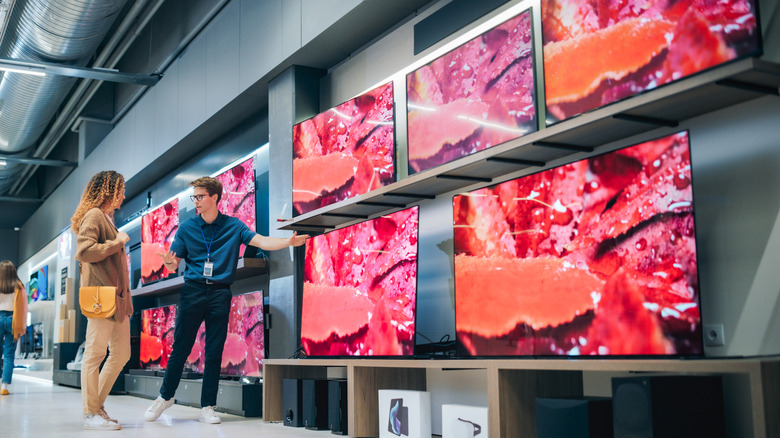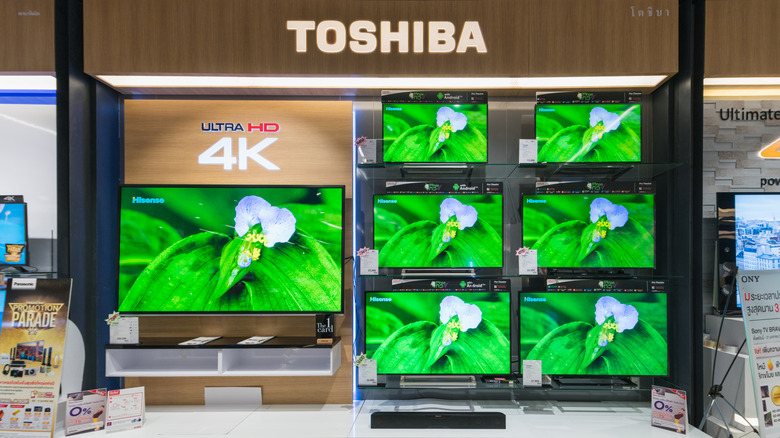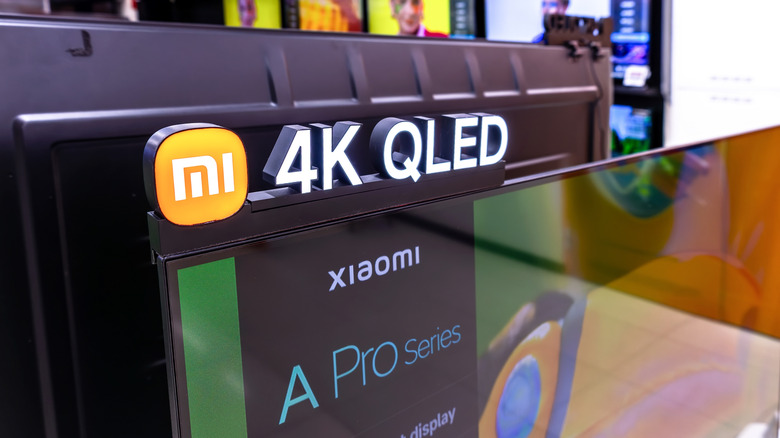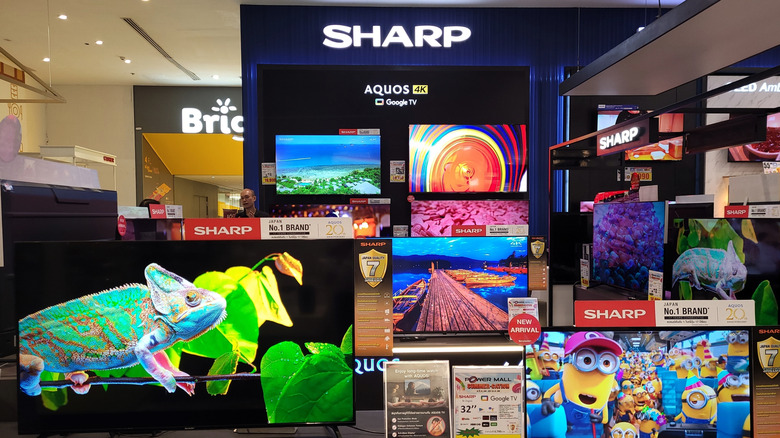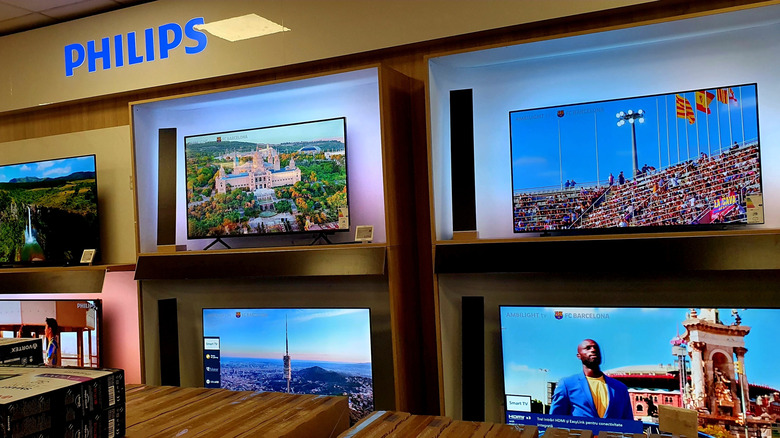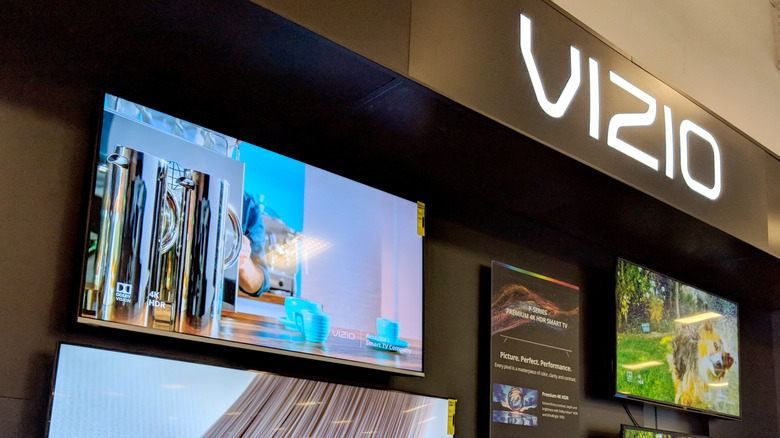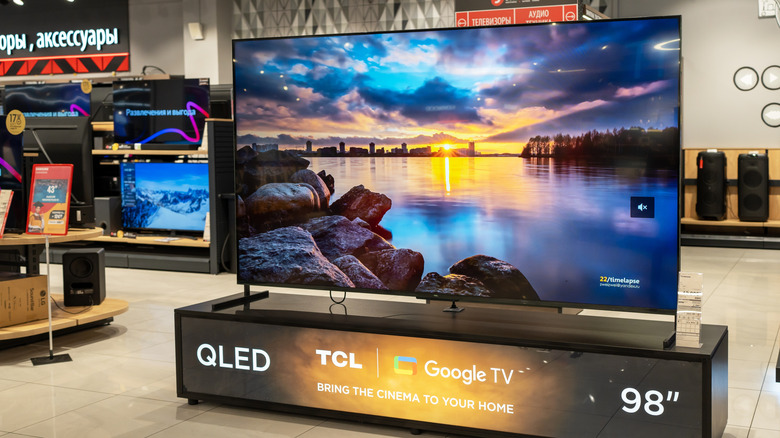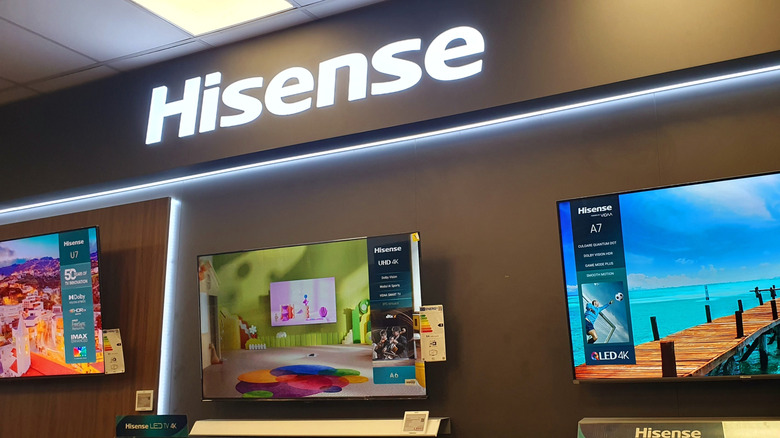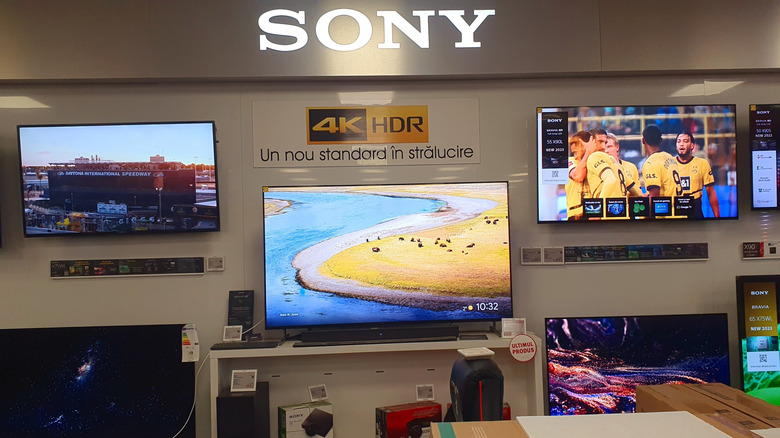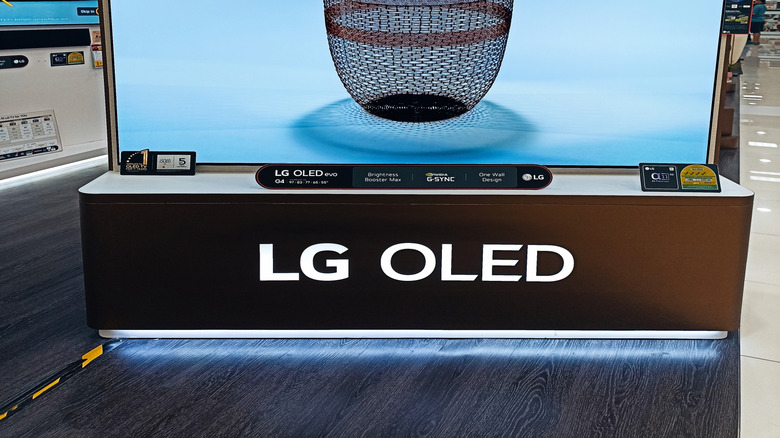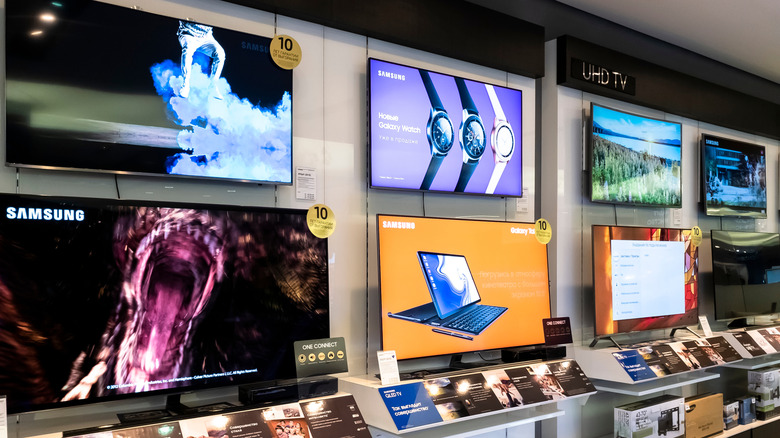Ranking 10 Of The Most Popular TV Brands From Worst To Best
We may receive a commission on purchases made from links.
From the massive CRT TVs of the early 20th century to today's cutting-edge 8K and OLED panels, the evolution of television technology is long and storied. This technological transformation is accompanied by major shifts in brand dominance, and, according to research by the audio, video, and media specialists at Xperi, American consumers have clear priorities when choosing their TVs. Among them are image quality and a wide variety of content options. However, Americans also look for easy access to that content, and, naturally, they want good value. They may buy a TV purely on recommendation, while almost half choose on brand reputation alone. With these insights, we can start to see why certain TV manufacturers are dominating today's marketplace.
So, which TV brands are the most popular? Well, there are dozens of good ones out there, but certain companies stand out from the rest. These brands don't just push the latest technology; they deliver a combination of performance and features that consumers actually want at prices they might be able to afford. We've consulted multiple sources, including statistics that show total sales on top of consumer trust and satisfaction. However, we should point out that any TV brand that finds itself lower down on this list is not necessarily a bad brand. In fact, we should commend them for making the list given the competition out there. So, with that, here is our ranked top 10 of the most popular TV brands today, from worst to best.
10. Toshiba
Toshiba's roots stretch all the way back to 1875. Over the decades, it has established itself as a major player in the electronics market thanks to a wide range of top-tier products — most notably, its competitively priced TVs. And while reaching any top 10 ranking of TV brands is commendable, it sits at the bottom of this list because surveys show only 2% of U.S. residents claim to have a Toshiba as their primary television. However, in terms of consumer trust, Toshiba earned a respectable fifth place in a study by America's Most Trusted.
The televisions the Japanese giant offers include a solid selection of 4K smart TVs, including Fire TV Editions with seamless access to Amazon's streaming platform. In the U.S., however, Toshiba only sells two primary series: The 4K C350 and the HD V35. We listed the Toshiba C350 as one of the best 4K TVs in 2022, and it certainly is a budget-friendly gateway to premium high-resolution entertainment. It also delivers the complete Fire TV experience across multiple screen sizes while packing HDR capability and an arsenal of audio technologies. That said, you need to consider that the TV's heart beats strong for the Amazon ecosystem, which means other streaming platforms receive second-class treatment or may even be locked out.
9. Xiaomi
Xiaomi made solid progress in the smart TV market after releasing an impressive lineup in 2025. However, it has received genuine recognition for many years, including a listing by International Brand Equity (IBE) as one of the 10 best TV manufacturers in the world. Unfortunately, you won't find many sets in the U.S. That's a market too far for the Chinese company, at least for now. Which is a shame because the solid value Xiaomi provides easily wins people over. Its TVs are often packed with features that challenge high-end competitors, all while keeping bank accounts surprisingly intact.
Among the more popular models are those in the Xiaomi TV Max 2025 series. With massive 85- or 100-inch QLED displays and all the most important TV specs covered, these sets are true entertainment colossi. Another standout is the Mi TV Q1 75. It's a 75-inch TV that combines 4K QLED brilliance with a virtually invisible bezel design and audio that notably exceeds TV speaker expectations. In fact, TechRadar called it "the most gorgeous, affordable 75-inch 4K TV you'll never see." All in all, the company's televisions are basically cinematic monsters abroad, but in the U.S., Xiaomi is just another "not available in your region" tease.
8. Sharp
When Sharp released Japan's first commercially available TV set in 1953, it marked the start of a journey that would eventually lead to the company pioneering the 8K TV market. Today, Sharp's innovation extends beyond display technology to the smart TV experience. At CES 2025, it announced a partnership with TiVo to launch TiVo-powered smart TVs in the United States. Sharp TVs in the U.S. have long been known for their user-friendly and reliable Roku interface, but with this 2025 launch, the company's devotees now have two excellent smart platforms to choose from — and this is one factor that American consumers value highly.
But it's not just about historic innovations and ease of use that appeals to consumers. Sharp TVs are competitively priced, too. Its U.S. lineup predominantly features 4K displays with universal HDR support, while the Roku TV platform provides access to a vast entertainment library of over 500,000 movies and TV episodes. However, in the USA, Sharp has only a modest presence in living rooms. It holds just a 1% share of the market, while abroad that figure stands at a more respectable 2.4%. Sharp also earned sixth place in America's Most Trusted Television Study for 2025, and popular models include the recently launched Sharp AQUOS OLED 4K series, while the 55-inch AQUOS QLED Smart TV Powered by TiVo delivers the television essentials of solid picture quality, decent sound performance, and a user-friendly interface at a very reasonable price.
7. Philips
Philips was founded back in 1891 in the Netherlands, and following World War II, the Dutch firm brought its first TVs to the world. It soon established itself as a market leader, and though it no longer holds such a lofty position, Philips has maintained a strong focus on audiovisual innovation, with the unique Ambilight rear lighting becoming its signature feature. In 2018, the company went a step further and enhanced their premium TVs with custom-designed sound systems in a collaboration with renowned audio brand Bowers & Wilkins — a partnership that continues today.
More recently, Philips has focused on the display, with its 2024 lineup showcasing advanced MLA OLED tech that can hit an exceptional peak brightness of 3,000 nits. Together with the latest Ambilight Plus technology that color-matches what's on the screen, flagship Philips TVs give you cutting-edge home theater. The 65-inch OLED+959 has all of this tech, and its impressive 5.1.2-channel Dolby Atmos sound system provides 102 watts of power through 18 strategically positioned drivers. TechRadar said it's a "visually and sonically striking TV," but "pricey compared to rivals."
However, if you're in the U.S., you can forget about this model, as Philips discontinued operations in the American market in 2008 and transitioned to a brand-licensing arrangement. Under this agreement, Funai Electric handles manufacturing, marketing, distribution, and support for budget Philips TVs in the U.S., ensuring the brand still has a 3% presence in American households. However, Philips keeps its premium TVs exclusively in international markets, where they account for 2.4% of the global TV market share.
6. Vizio
Operating from its California headquarters in Irvine for over two decades, Vizio has established itself as America's go-to brand for quality budget TVs. As a homegrown company, it offers affordable 4K TVs to U.S. consumers and holds a highly respectable 11% of the U.S. TV market. Vizio offers a variety of models, from basic Full HD displays to 4K LED and QLED units equipped with smart capabilities. Vizio SmartCast includes the WatchFree+ platform, which offers comprehensive streaming options, including more than 300 free channels, alongside major streaming services, while its award-winning customer service consistently earns positive reviews.
The company's latest models have started to integrate features valued by gamers, and the M-Series Quantum X supports 240Hz at 1080p and 120Hz at 4K, plus HDMI 2.1 connectivity, albeit only from one port. Dolby Vision and HDR10+ are also supported for sublime cinematic viewing, and you can get all this for under $600. The current flagship is the Vizio Quantum Pro. Like the Quantum X, it features comprehensive gaming support, and they come in display sizes of 50, 65, and 75 inches. Alternatively, the V-Series is a more budget-conscious TV offering, but it doesn't sacrifice essential features and offers excellent value in a range of sizes from 43 to 75 inches.
5. TCL
Founded in 1981 in China, TCL has emerged as a TV-industry giant with 12% of the global market share. This is a brand that pioneered Mini-LED technology in 2019 and has since established itself in over 160 countries, including a strong North American presence. Its reputation is built on quality, affordability, and innovation, like the 98-inch X955 QD-Mini LED TV it brought to global markets in 2024. Promoted as the "Dual 5000," in reference to its unprecedented 5,000-nit peak brightness and 5,000 full-array local dimming zones, it set new standards in premium home theater TVs. The bad news is, however, this flagship is unavailable in the U.S. market. But Americans still have access to many of the company's other models — and the good news is, even TCL's budget TVs punch above their weight.
With QLED and Mini-LED models delivering a picture quality that approaches OLED performance, there really is plenty for consumers to get excited about. The TCL 4-Series is the sweet spot for budget-conscious buyers. Models in this range combine 4K resolution with HDR support, while the 5-Series utilizes QLED technology, plus gaming enhancements like VRR and ALLM. Flagship models available in the U.S. include the QM8K QD Mini-LED TV. It features 3,000-nit peak brightness and ultra-smooth 288Hz VRR. In 2025, TCL is one contender that is sure to challenge the established players. As of 2023, the company already had a 5% slice of the American pie and was starting to make inroads into the premium market.
4. Hisense
Another rapidly emerging Chinese TV brand is Hisense. It boasts an extensive lineup of TVs, from basic budget options to premium flagship displays. Its evolution into a global powerhouse has been a long journey, but its strong presence in the U.S. is mainly due to quality products at attractive prices. Its TVs consistently deliver impressive specs, with Hisense making waves in the 4K and Mini-LED markets thanks to impressive brightness, effective local dimming, and support for all HDR formats. Its more recent flagship offerings combine Mini-LED tech with IMAX Enhanced viewing modes and sophisticated surround sound. Yet, the company still prices its sets significantly lower than its competitors.
Industry experts and consumers consistently rank Hisense highly when it comes to value, but the company is not all about budget TVs. Like TCL, it's experiencing considerable gains in the premium market. The 85-inch U8 Series Mini-LED is one standout in this push into the high end. On the other hand, the 43-inch A7 UHD 4K offers double-take value at under $250. Hisense ties with TCL for a 5% share of the American television market and ranks fifth in the world at 8.7%. An American Customer Satisfaction Index (ACSI) survey also shows Hisense to be up there with the best, ranking a very commendable third, ahead of TCL and Sony.
3. Sony
Sony has been building its television legacy since 1946, and in recent times it has been flourishing on the premium market. The company is credited for having created the direct-view portable transistor in 1960, which introduced genuine mobility to televisions. Other notable milestones include the 1968 KV-1310, which introduced Trinitron color technology that gave us brightness and image quality so good that it established Sony as a global dominator. The Japanese giant also gave us the first consumer LED backlit TV in 2004, and in 2007, it pioneered another first when the XEL-1 kicked off the OLED revolution. Nowadays, Sony TVs still deliver a combination of brightness, color accuracy, and detail that has its rivals looking on with envy. Audio also outperforms competitors, while current models have introduced important gaming features.
What Hi-Fi insists the Bravia 8 stands out as the best Sony TV, declaring it their "Product of the Year Winner" for 2025, mentioning that it delivers the "best picture quality available on any TV in its price range." The "good at everything" Sony Bravia 8 II is also a bit of a beast with its QD‑OLED picture quality, class‑leading processing, and capable built‑in audio. The company ranks fourth in the U.S. with a current market share of 7%, but its global share is somewhat less at 4.1%. Sony is also recognized when it comes to consumer trust, with Lifestory Research ranking it number one in 2025, although this is muddled by a slight decline in its ACSI score reflecting customer satisfaction.
2. LG
LG has maintained its position as a world leader in OLED technology for over a decade now. It's the Korean firm's pioneering work in display innovation that has established modern standards for TV picture quality. True blacks, rich and accurate colors, and expansive viewing angles with virtually zero image deterioration are the hallmarks of the best OLED TVs, and it's all down to LG. So much so that its displays are used in the majority of OLED screens found in Sony, Panasonic, and Samsung televisions. LG also earns widespread recognition for balancing these impressive capabilities with competitive pricing and advanced features. The latest and greatest LG models all feature 4K resolutions with comprehensive HDR support and advanced HDMI 2.1 connectivity with eARC as well as VRR and ALLM for optimal gaming performance.
The company's lineup offers distinct advantages across every TV series it manufactures. The C series, especially the LG C4 — one of the best smart TV models of 2024 — is noted for its overall performance and value, while the B series focuses on affordability. Step up to the G series, and you'll find models with enhanced brightness and style, particularly the LG G5, which stands as its 2025 flagship. It offers groundbreaking Primary RGB Tandem OLED tech and the latest generation of the Alpha 11 AI Processor for performance levels that surpass anything the company has released before. Bearing all this in mind, it's unsurprising to find that LG holds a substantial 19% share of the American TV market, while its 12.8% global share is highly commendable. The 2025 America's Most Trusted Television Study also found LG to be highly regarded. It ranks third, just behind Sony and Samsung, while just a slight decline in the ACSI customer satisfaction survey shows LG is still well-regarded.
1. Samsung
For almost two decades, Samsung has led the global TV market. It has built its industry leadership on consistent innovation that continues to shape modern TVs. The Korean company originally focused on manufacturing for other brands, but over the last couple of decades, it has transformed from making budget imitations into a company with sophisticated design at its core. Samsung states that its TVs "stand out for top-tier picture quality and audio-visual performance," with its MICRO LED displays setting new standards of color intensity and brightness.
With a 23% share of the U.S. market as of 2023 and a 19.8% grip on the global market, consumers are voting with their wallets in agreement. Samsung's sales have been primarily achieved through cutting-edge QLED and Neo QLED display technology, exceptional picture quality, excellent AI upscaling, and even 8K resolution TVs. However, it also ranks highly in consumer trust, with America's Most Trusted placing it second in its Television Study, while it scores higher than any other brand on the American Customer Satisfaction Index.
In terms of its best TVs, TechRadar rates the Samsung S90C as the best overall. The advanced QD-OLED panel delivers exceptional brightness and rich contrast, supports 4K/120Hz gaming with VRR, and is powered by the Neural Quantum 4K processor for superior upscaling. However, tech experts place the S95F as the best premium offering, and its sophisticated 4.2.2-channel 70W audio system with Dolby Atmos and Object Tracking Sound makes it an excellent choice for audiovisual immersion.
Methodology
We looked at a variety of sources to rank the top 10 TV brands, including data from the American Customer Satisfaction Index (ACSI), market research from Lifestory Research, analysis by International Brand Equity (IBE), Visual Capitalist's U.S. main‑TV ownership survey, and various other relevant data such as consumer reviews and ratings. We considered all the data (where available) side-by-side and ranked each brand's strengths and weaknesses based on our own analysis.
